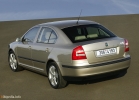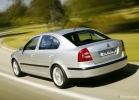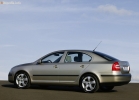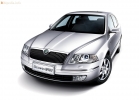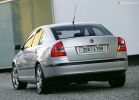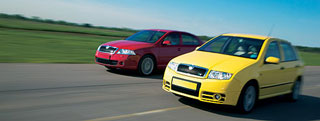Skoda Octavia II 2004 test drive - 2008 -
Octavia from $ 11.500

After the appearance of the Octavia in 1996, built on the Golf platform, it became clear that the Volkswagen concern has serious intentions regarding the Skoda brand. Seven years later, from the beginning of the release of the model, it can be safely argued that fears about the low quality of the Czech assembly were in vain.
Engines
The most modest 1.6 -liter gasoline engines were produced in two versions - with a capacity of 75 and 101 hp. 75 hp engine It is inferior to 101-strong mainly at high speeds, but has more elasticity and, when calmly driving in the city, is quite coping with its task, although, of course, the dynamics of a car with such an engine is average. There are no frankly weak places in the design of 1.6-liter engines, all concerns about them are reduced to timely maintenance. Twenty -valve engines with a volume of 1.8 liters were produced both in atmospheric and turbocharged. The AGN atmospheric engine was quite unsuccessful primarily due to the design of the gas distribution mechanism. The timing belt on these engines, unable to withstand the required mileage, was often torn, which led to an expensive repair of the block head. Experts also advise when replacing the timing belt (it is advisable to observe the interval of not more than 60 thousand km, the cost of the operation is $ 220) check the state of the pump given by this belt, and if there are the slightest signs of its wear, change. Otherwise, the pump can be jammed, and again you will have to repair the head. And the block heads themselves sometimes failed with a relatively small run. Since 2000, the installation of the AGN engine on Octavia has been stopped. Oddly enough, on turbocharged engines, which, in fact, have the same design, the above problems are less common, but are present, so all the recommendations are the same. In addition, it must be remembered that the turbine has a weak place - a thin drainage hole located next to a hot exhaust manifold. With the untimely replacement of oil or when using a poor -quality, this hole is quickly coined and the turbine fails. It is impossible to check what condition is drainage and how long the turbine will last a turbine. If the noise is heard in the back of the block head, then the tensioner of the chain connecting the camshaft is worn out. This indicates a mileage significantly exceeding 100 thousand km, or that the owner saved in oil. So when buying, you should think about whether to stop your choice on this car, because a large run or low -quality oil probably negatively affected the engine's resource.
They speak very well on services about a 2-liter engine that replaced atmospheric 1.8. Its only drawback - a slightly increased oil consumption - was caused not by the most successful construction of the crankcase ventilation. Since 2002, the design of this node has been changed, and the problem has disappeared. Perhaps, among the Octavia gasoline, it is a car with a 2-liter engine that is the most preferred acquisition. As for the service, it should be remembered that all engines without exception are demanding of the quality of the oil, you need to use synthetic 5W40, the frequency of oil and filters - 15 thousand km, the cost is about $ 110. With untimely replacement of the air filter, the failure of the air flow sensor ($ 250) is likely. Candles are supposed to be changed after 60 thousand km, but on our gasoline they, as a rule, fail much earlier. Their replacement costs $ 50. Due to the quality of gasoline, the manufacturer also does not stipulate the service life of lambda-zond, it is necessary to change it as it fails ($ 100).
Diesel engines on Octavia installed mainly two - XF and AGR. Both of them with a volume of 1.9 liters, turbocharged with direct injection. XF - more powerful (110 hp against 90 hp in AGR), which is achieved by installing a turbine with variable geometry. The fuel equipment of both suffers mainly due to poor-quality diesel fuel and the presence of water in it. And the repair of the fuel pump is very expensive. It is also necessary to monitor the pressure of crankcase gases. If it rises in excess of the permissible, you should replace the garter gases (approximately $ 150), otherwise it can squeeze the crankshaft oil seals and the oil will enter the timing belt with all the ensuing consequences. After three to four years of operation, it happens, air flow meters are out of order, the replacement of which costs $ 240. The replacement of the timing belt is provided after 90 thousand km, the cost of the work is $ 310, butter and filters should be changed every 10 thousand km ($ 110).
Transmission
The transmission is quite reliable, it does not cause much trouble to owners, with the exception of turbo engines - both gasoline and diesel. They have a two -mass flywheel with a damper of steep fluctuations, and with a run of 100 thousand km, the destruction of the damp springs is possible. The fragments fall into the clutch crankcase and begin to break everything that is found in their way, so that often the gearbox often suffers from this. Therefore, if, when buying a car with a turbo engine from a clutch crankcase, extraneous sounds will be distributed, it is better to refrain from acquiring such a car, since the consequences and amount of repair costs in this case are unpredictable. There were also cases on powerful engines when the attachment of the differential gear was cut. Such boxes changed according to the warranty, and then instead of rivets the gear began to be attached to bolts, and the problem disappeared, so it is unlikely that such a box will fall on the second-hand market, since such problems arose even with small runs. In mechanical KP, oil is flooded that does not require replacement, but if you still replace it after the purchase, it will only be better. It is worth using a 75W90 transmission oil. There are no special complaints according to the automatic KP, the oil is provided after 75 thousand km of the run, and the automatic transmission lubricant is separate: 75W90 should be poured into the differential, directly in the automatic transmission - DEXTRON III. Circules serve for a long time, you only need to monitor the anthers.
Suspension and steering
The simplicity of the suspension design is determined by a small number of problems arising with it. Ahead-racks of Mcphereson, behind-a N-shaped beam, especially since balls, silent blocks, and shock absorbers withstand a mileage of 100-150 thousand km, in addition, the cost of suspension spare parts is relatively low. At one time, cars with the glued stabilizer bushings came off the assembly line, which is why the stabilizer was triggered at the contact site with bushings and began to knock. This does not particularly affect safety, but, in a good way, such a stabilizer requires replacement, and this operation costs $ 110, so you can bargain when buying. The bearings of the front hubs (130 dollars with replacement) may fail, but no pattern is found here, apparently, the quality of the parts supplied to the conveyor in different parties differs. With the rear suspension, there are fewer problems, as the service employees say, two silent blocks - there is simply nothing to break there. The rear shock absorbers serve about the same as the front ones. The steering racks are surprisingly durable, sometimes they can flow seals, but this is easily repaired. Steering rods ($ 150 per replacement) withstand about 100 thousand km, tips - about 60 thousand km.
Brake system
The front brakes are disk, the rear, depending on the engine power, either drum or disk. The front brake pads are enough for about 30 thousand km, the brake discs have to be changed at every third change of pads, that is, after 90-100 thousand km. The pads of rear disc brakes require replacement after about 60 thousand km, and drums last even longer. Because of salt, ABS sensors may fail, but this is typical for all cars operating in Russia without exception.
Body and electrical equipment
Octavia is available with two types of bodies - hatchback and station wagon. Do not forget that it is built on the Golf platform, so you can’t call the salon especially spacious. First of all, this applies to the legs for the legs of the rear passengers - people with growth above the average in the rear seat will be inconvenient. The corrosion resistance of the body is quite high, the appearance of rust is marked only on the edge of the rear door in the places where it rubs on other details, and under the frame of the license plate, which, vibrating, slowly erases the protective coating. During operation, the doors are sagged, but the bodywriters put them in place, simply pulling it thoroughly over the edge of the door up, and do not even resort to adjusting the loops. After such an amendment, the doors function normally for a long time again. The quality of the finishing materials of the cabin corresponds to the price of the machine, so the creaks of the upholstery of the doors, especially in dry weather, is common for Octavia. There are frequent cases of cracks on the windshield - either the body is not hard enough, or glass of this quality. There are also cases when, without a visible reason, they burst into pieces, windows of the fifth door - again, the manufacturer does not call the reason. Most likely, to eliminate it, it is necessary to process the design of the fifth door or replacement of glass with a thicker, which is quite expensive, so it is easier to change glass according to warranty. There is no longer a guarantee for machines at the age, so $ 150 for replacement will have to pay the owner.
There are practically no problems in electrical equipment. On 1997 cars, the central locks sometimes stop working, it is necessary to change the actual mechanisms in the doorway - their service life, as it turned out, is about six years. The 2001 cars were previously equipped with a third -generation immobilizer, and they have problems with the launch in the winter season, but this is characteristic not only for Skoda.
conclusions
Octavia is not the worst choice among used cars. Simplicity of the design, quite high reliability of the main nodes and assemblies, a spacious trunk are arguments in favor of buying such a car. On the other hand, a huge number of these machines were purchased as official and quite intensively operated, so when buying there is a high probability of meeting just such a car. Outwardly, it can be quite neat, but with great mileage, so when buying it is better to diagnose on a specialized service. Of the entire range of cars, the option with a 2-liter gasoline engine looks most preferable, but others should not be discounted. For 3-year-old Octavia in Moscow they ask for from 11.5 thousand to 19 thousand dollars.
Text: Leonid Klimanovich
Source: Avtopanorama magazine
Video crash tests Skoda Octavia II 2004 - 2008
Skoda Octavia II 2004 test drives - 2008
Skoda Octavia II 2004 Krash Test - 2008
Krassh Test: Detailed Information27%
Driver and passengers
17%
Pedestrians
37%
Children-passengers
Malfunctions Skoda Octavia II 2004 - 2008
Skoda Octavia malfunctions: Detailed information| Octavia II 2004 - 2008 | |
|---|---|
| Engine |  |
| Transmission |  |
| Control system and suspension |  |
| Brake system |  |
| Air heating and air conditioning |  |
| Launch and charging system |  |
| Electric components and so on |  |
| Corrosion body stability |  |

